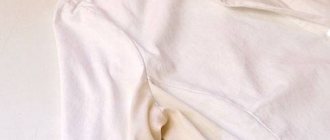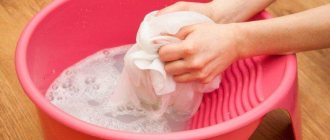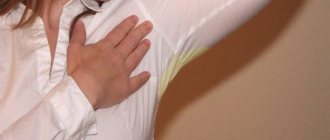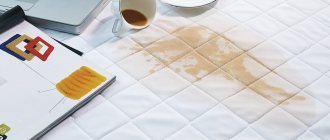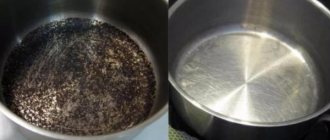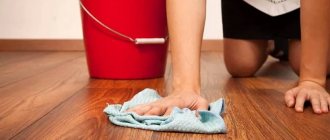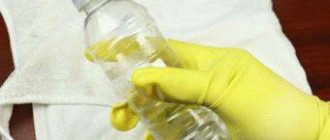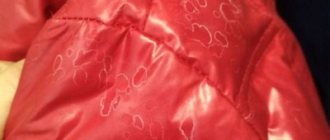White clothes help create a laconic look and are easy to combine with things of any color. But yellow stains on white are a real problem, because detergents cannot remove them. The easiest and most reliable way is to go to dry cleaning, although stains can actually be removed with improvised means. The main thing is to find out the cause of the pollution and choose the appropriate method to eliminate it.
Why do yellow spots appear on clothes?
Yellow spots on clothes come from different origins. Each type of pollution requires an individual approach to elimination.
Stains are formed due to various liquids and fatty compounds that are absorbed into the fibers of the fabric:
- tea, coffee, lemonade, white wine, herbal juice;
- Eau de Toilette;
- sweat;
- deodorants and antiperspirants;
- vegetable and animal fats.
This may also be due to mechanical stress or improper washing:
- Thermal “burn” of the material from the iron or water during washing if the temperature is exceeded.
- Long-term storage in an unventilated or damp place.
- Poor rinsing, after which the powder or gel particles in the fabric fibers react with oxygen.
- Unsuitable detergent for washing - for example, aggressive powder for delicate fabrics.
- Hard water. It contains magnesium and calcium salts, which are difficult to remove from fabric fibers when rinsing. Stagnant water during steaming has the same effect.
- Traces of rust. They can appear from low-quality fittings.
Causes
Grouped together, we can name only three reasons why yellow spots appear on clothes and underwear:
- improper care: washing in hard or too hot water, incorrectly selected washing powder, less often gel, insufficient rinsing after bleach, inappropriate ironing temperature;
- pollution: sweat, vegetable fats;
- long-term storage with impaired microclimate.
Advice On store shelves you can find many different special products that help get rid of yellow spots, but, unfortunately, not all of them are particularly effective and do not always guarantee one hundred percent results.
An alternative to purchasing special, often expensive, products is to use hand-made solutions, which will be discussed below.
Handy methods
Experienced housewives have a lot of remedies for stains on white things. If you have never removed stains using traditional methods, carefully study each method and evaluate whether it is suitable for your fabric.
Hydrogen peroxide
Household bleach can be replaced with 3% hydrogen peroxide. There are different options for removing yellow spots using peroxide, we have chosen the most popular:
- Method No. 1. Add 2-3 tbsp to a bowl of water. l. peroxide. Next, the contaminated item is soaked in the solution and left for 30 minutes. After this, wash as usual and rinse thoroughly.
- Method No. 2. The effect of peroxide is enhanced with tea soda and dishwashing gel: 2 tsp. peroxide, 2 tbsp. l. soda and 2 tsp. dish gel. Make a paste from the ingredients and apply it to the stained area. After 20–30 minutes, rub the mixture into the fibers of the fabric and rinse the item thoroughly.
- Method No. 3. Pour a little peroxide onto the stain and dip the item in warm water. After a chemical reaction with hissing, the product is washed in the usual way.
Ammonia and citric acid
You can prepare a bleaching solution by mixing ammonia with citric acid. A powerful blend that removes problematic sweat and deodorant stains. Mix 1 tsp. each product and dissolve in water. Soak items in the solution for 3 hours. Rinse and wash as usual.
Aspirin
Two tablets of regular aspirin or one effervescent one are dissolved in a tablespoon of water, rubbed into the stain and left overnight. In the morning, the item is washed with detergent.
Vinegar with laundry soap
Table vinegar is another household stain remover. Laundry soap added to the solution enhances the whitening effect. How to remove yellow stains on white using these products:
- Dissolve crushed soap in vinegar (1:1).
- Apply the mixture to the stained area.
- Leave for 1–2 hours.
- Rub and rinse or wash in washing machine.
Bleach + vegetable oil
These two products alone can cause yellow spots, but when used together they have a whitening effect.
There are two proven methods:
- Method number 1. Add 2 tbsp to 5 liters of hot water. bleach (no chlorine), stain remover, vegetable oil and 6 tbsp. washing powder. Soak dirty items in the solution and leave overnight. In the morning, wash them in the machine and dry them.
- Method number 2. Apply the oil to the problem area for a quarter of an hour. Wash off the oil by hand with dish soap containing glycerin. Soak the item in water and bleach in the proportion recommended on the label. Wash and dry.
How to remove a dark, greasy stain after washing?
First of all, it is necessary to wipe the cuff dry after each wash, preventing mold from growing. If you notice an unpleasant smell of dampness, we advise you to load 20 g of citric acid into the drum and run the hottest mode.
How to remove a dark, greasy stain after washing:
- This may be 90 or 95 degrees, depending on the model of household appliance. If the tray is to blame, it also needs to be cleaned. Old mold, as well as limescale, are difficult to remove from the surface of the tray, so pour a small amount of chlorine bleach or alkali solution. Any stove, toilet, and sink cleaner will do.
- Be sure to rinse the tray thoroughly using an old toothbrush. Dirt can accumulate in the filter, where mold can sometimes grow. Therefore, we recommend opening the window, which is located on the right or left side. It is closed with a rectangular or round plug. You need to pry it out with a screwdriver, the window will open. Next, you need to turn the filter, remove it, and wash it thoroughly.
- This area usually contains a large amount of coins, hair, wool, and mold may accumulate. Be sure to wipe with a dry towel after cleaning.
Removing stains
To prevent stains from appearing, we recommend loading household appliances without laundry, with citric acid or soda about once every 3 months. If, after carrying out all the above manipulations, stains still appear on your clothes, contact a household appliance repair service. Most likely, the reason is a malfunction of the oil seal, pump, or other parts of the device.
Household chemicals for removing yellow spots
Specialized household chemicals successfully remove yellow stains from white clothes. Stain removers are used for white and colored items, bleaches are used only for whites. Liquid and gel products are suitable for thin and delicate fabrics; more aggressive powders will remove yellow stains from cotton and denim. The method of application and exposure time differ for different products; read the packaging. Here are some effective bleaches:
- Liquid stain remover Vanish OXI Action. Removes any stains, refreshes white clothes, enhances the effect of the detergent. The approximate cost is from 130 rubles for 450 ml.
- Bleach SARMA Active. An effective remedy for any contamination. Suitable for all types of fabric. Does not contain chlorine. The approximate price is from 105 rubles per 500 grams.
- Bleach Bos plus Maximum. Removes stubborn stains and preserves the color of the product. Works even in cold water. Approximate price - from 59 rubles for 250 g.
Adviсe
Many people may think that removing yellow stains from white clothes made from absolutely all types of fabric is easy, but, unfortunately, this is not the case. To successfully remove yellow sweat stains from clothes, you need not only to know how to prepare cleaning solutions, but also tips that will help you not ruin your white item. Miss Clean magazine recommends paying attention to the following nuances:
- To clean white items, it is highly undesirable to use solutions containing chlorine.
- Solutions with acetone and acetic acid are not suitable for cleaning silk items.
- Before you start cleaning things from yellow stains, you need to conduct an experiment. Just apply the prepared solution to any unnecessary item of the same fabric and see if the item loses its qualities.
- The recommended temperature for washing white items with yellow stains is 20-30 degrees. Boiling, as already mentioned, spoils the structure and thins the canvas.
If you notice that yellow spots have formed on your favorite white item, do not be upset and throw it away. Perhaps the tips and recommendations described above will help you put things in complete order.
Features of processing different fabrics
When removing yellow stains, take into account the type of material so as not to spoil the item during the bleaching process.
Cotton
The easiest way to remove yellow stains is from cotton. The material tolerates most household bleaches: vinegar, tea soda, salt, hydrogen peroxide, chlorhexidine, citric acid, laundry soap, alcohol and even boiling. The latter method is suitable for removing stains from collars and cuffs of cotton shirts. Add grated laundry soap to cold water, place the soiled clothes in the container and boil for 30 minutes, stirring from time to time.
Synthetics
Items made from synthetic materials are most sensitive to the effects of aggressive stain removers, so do not use acetone, solvents, acids or chlorine-containing household chemicals when washing. The best option is oxygen bleach or gel for washing light-colored fabrics.
Denim
The peculiarity of denim is that coarse fibers quickly absorb liquid. Therefore, the main thing when treating stains is efficiency, especially if they are oily. Remove excess stubborn substance with a napkin, and then use one of the following:
- lemon juice + water (1:1) for 1 hour;
- hydrogen peroxide + vinegar (1:1) for 3 hours;
- soda + sparkling water (3:1) for 8–12 hours;
- aspirin + water (4–5 tablets per 1 tablespoon) for 8–12 hours.
Baking soda and aspirin can be left on the fabric for up to a day if the stains are difficult to remove. A few more remedies for various stains:
- Fat yellow stains on denim are covered with talcum powder, baby powder or a sugar substitute for 6–8 hours. Then wash with the addition of dishwashing detergent.
- Remove coffee and tea stains with egg yolk. Apply it to the problem area, rub in and leave for 1-2 hours. After this procedure, you need to wash thoroughly with conditioner.
- Plant sap is absorbed into denim fibers with particular force. Treat such stains from the inside out with hair shampoo and a sponge.
Wool
Wool, even coarse wool, does not tolerate the effects of vinegar, citric acid, industrial stain removers and washing powders that form salts in reaction with water. How to remove yellow stains from wool clothes:
- use laundry soap with a whitening effect;
- soak things in glycerin dishwashing gel.
To prevent stains and stretching of the fabric, wool items are dried horizontally on a white towel without using a hair dryer or iron.
Silk
Products containing acid or chlorine are also prohibited for bleaching silk fabrics. Effective ways:
- hand wash with white laundry soap (rub, wait an hour and a half, wash);
- soaking for half an hour in vodka diluted with water 1:1;
- treatment with sodium thiosulfate (ampoule per basin).
Fur
The fur is resistant to usual stains, but turns yellow if stored improperly. The reasons are increased indoor humidity, excess light, dust and accumulation of sweat. You can keep your fur beautiful if you take the product to the dry cleaner in a timely manner, at the end of the season. There are several cleaning methods used at home:
- Wet method. Purified gasoline, vinegar, hydrogen peroxide or citric acid are sprayed onto the pile from a spray bottle. After drying, the fur is combed.
- Dry method. Chalk, heated flour, sawdust, bran or starch are rubbed into the fur, then shaken out, brushed or removed with a vacuum cleaner.
- Mixed method. Chalk or starch is dissolved in vinegar or lemon juice and applied to the pile. The dried mixture is removed with a brush. Or the fur is moistened with gasoline and sprinkled with starch. After 40 minutes, the product is shaken out and cleaned with a brush.
Linen
To remove yellow stains from linen, use the same means as when bleaching cotton products. Oxalic acid is suitable for rough linen clothing. It is dissolved in water (1 teaspoon per glass) and applied to the problem area. After 15 minutes, the item is washed with the addition of gel.
Kids' things
Wash children's clothes only with safe detergents. After washing clothes with chemical or aggressive stain removers, wash items with hypoallergenic detergents for children or sensitive skin. To ensure that clothes retain their color and shape longer after aggressive exposure, use conditioner.
The nuances of removing different types of traces
The origin of yellow marks on clothing determines which method will be most effective in combating them.
From sweat
Citric acid removes sweat stains from white sweaters:
- For 1 liter of water take 15 grams of powdered citric acid.
- Heat the liquid to 70 degrees and dip the soiled items into it.
- After 5-10 minutes, take it out, rinse and wash.
Instead of a powder product, a slice of fresh lemon will do. It is used to smear yellow spots, and after 15 minutes they are sent to be washed.
From the iron
If white fabric has just been damaged by an iron that is too hot, traces of it can be removed with boric acid. Moisten a cotton swab with it and gently rub the burnt spots with it until they disappear completely.
After washing
You can remove yellow stains after washing using:
- hydrogen peroxide;
- acetic acid with soap;
- washing with the addition of oxygen bleach.
Why they appear after long-term storage and how to remove them
If there is high humidity and mold in the room where laundry is stored, stains may form on the clothes. They can be removed by boiling things with the addition of soda:
- For 5 liters of water take 4-5 tbsp. soda
- Place things in a bucket with the solution and let it boil for 20-30 minutes.
- Wash on a suitable program.
Is it possible to paint over stains on fabric and how to do it?
If the listed remedies do not help, the yellow spots are painted over. The color of light, monochromatic items can be simply refreshed or radically changed with factory dyes. Dye only things made from natural materials; synthetics are difficult to dye, and the result can be unpredictable. Fabric paints come in different forms: powder, paste or granules. Choose them not only by color, but also by type of material. For coloring:
- Wash and dry the item you will be dyeing in advance.
- Buy fabric dye in the color you want.
- Dilute the paint as written in the instructions. Use distilled water or soften tap water (1 teaspoon of salt per 10 liters of water).
Acid dyes are used for wool, and vinegar is added to the water, in addition to salt. After dyeing, silk is also rinsed in water and vinegar to consolidate the result.
Powder stains after washing, how to remove?
In fact, an overabundance of funds will not save the situation, but will make it worse.
Powder stains after washing, how to remove:
- After all, a large amount of powder is poorly washed out and can cause the formation of white stains, green, yellow or red spots.
- It all depends on the dye contained in the powder.
- In order to remove traces of white powder, you need to load the products into the machine again and turn it on, but without adding detergent. After rinsing again the problem will disappear.
After washing
Features of caring for white clothes
To ensure that caring for white items does not bring disappointment, strictly follow the recommendations:
- Before leaving, carefully read the manufacturer's label restrictions.
- Soften hard water by adding vinegar or citric acid to the washing powder. Avoid dry detergents in favor of gels.
- Place dirty clothes in laundry baskets with holes and dry clean ones thoroughly.
- When ironing, set the permissible temperature setting: if there is no label, focus on the type of fabric or check the heating of the iron on an inconspicuous area of the product.
- Boil flax and cotton by pouring cold water into the items in an aluminum or stainless steel container.
- For organic stains, do not use chlorine bleach.
- Wash children's clothes and underwear, especially those soiled by natural secretions, immediately or keep them separately from other items.
How to wash white sneakers without yellow stains
Successfully washing white shoes so that dark stains do not appear on them is difficult, but possible! To do this, you should follow some tricks and recommendations that will allow you to properly remove dirt and not harm the fibers.
Automatic or machine washable
You can wash shoes in a washing machine, but this should be done taking into account the following rules:
- Loading pre-cleaned shoes into the drum.
- Insoles are washed separately
- Choosing the right temperature and mode
- Adding additional fabrics to the machine to soften shoe impacts
To prevent sneakers from turning yellow after washing, it is better to use gel or liquid soap when washing. Before you start cleaning, you should remove the laces from your shoes (which are probably white) and wash them separately. This can be done in hot water with preliminary soaking.
The same should be done with removable insoles. This way the housewife has a better chance of putting white things in order!
Automatic washing should begin after heaters and dirt that could damage the automatic machine have been removed from the soleplate. Pebbles stuck in the soles can cause scratches on the drum or lead to cracks inside plastic machines.
At the same time, such particles are often endowed with coloring properties that can appear during washing. To clean shoes, you can use a brush or thick cloth. The fabric parts (toe) of the shoe also need to remove excess dirt.
To wash shoes safely while the drum is rotating, they can be placed in special bags. On the machine, you should select the “Delicate Wash” program, which occurs at low drum speeds.
This will prevent deformation of the products. The “spin” function should not be turned on for white sneakers! The minimum temperature for washing will be 35º Celsius. At the same time, the dirt will be able to be washed off, and no harm will be caused to the fibers, including the formation of dark stains!
Setting the extra rinse will completely rinse out any detergent particles from your shoes. This will also reduce the risk of yellowing of the fabrics.
Note! If your sneakers have scratches or holes, you should not put them in the washing machine. In such cases, manual cleaning comes to the rescue.
Handwash
Hand washing is less dangerous for white shoes, but more troublesome for housewives. The algorithm for carrying it out is as follows:
- Preparing shoes . The sole of the sneaker is washed, pebbles are removed and the laces are unlaced. Take out the insoles. Insoles and laces can be washed together under harsher conditions.
- Inspect shoes for difficult stains . Before carrying out a simple wash, you should get rid of difficult contaminants. So, using citric acid you can remove stains from fruit juice. Liquid soap can easily remove greasy stains. Hydrogen peroxide easily removes tea and coffee stains on white!
- Preparation of soap solution . Pour warm water into the prepared container and add a few drops of liquid detergent to it. Then shake the water with your hand until foam forms and place the shoes in it. The sneakers should be kept in the soap solution for some time (1 hour). During this time, the dirt will dissolve in the water, and it will be much easier to wash it off!
- Manual cleaning . After the required soaking time, you can add a little boiling water to the water (so that the solution becomes warm again) and soap, and then begin manual cleaning. A short hand wash will help remove all dirt from the white surface.
- Rinse . Clean sneakers should be rinsed in a sufficient amount of clean water, rubbing them together. This will remove the detergent particles completely from the fibers.
Finally, the shoes should be dried!
How to prevent yellow spots from appearing
Some tips on how to avoid yellow stains on clothes:
- Wash the detergent thoroughly from the fabric. When washing in a machine, use the extra rinse function.
- Observe temperature conditions when ironing and washing.
- Give items a good wringing before hanging them to dry.
- Don't use too much detergent. See the required quantity on the package.
- Don't wash too much laundry in the washing machine at one time.
Eliminating the consequences
When yellow spots appear after washing and you are sure that the cause was too much washing powder, the solution to the problem will be quite simple. You should turn on the rinse mode without adding detergent. This procedure will help wash away particles of undissolved powder. To avoid a similar problem in the future, think about preventative measures. Make sure that the washing machine is not overloaded and that the water supply is at sufficient pressure. You must follow the recommendations and add the required amount of washing powder to the load.
Sweat is washed off in a dozen different ways, which differ depending on the type of soiled fabric and the intensity of the contamination. Such markings are easy to recognize: they “decorate” the armpits, cuffs and collar. Often, ordinary laundry soap is enough to clean the problem area. If the method does not work, you will have to use a stronger drug. We recommend a cleaning solution consisting of baking soda, alcohol, vinegar, hydrogen peroxide and salt. The ingredients can be easily found on the kitchen shelf and in the medicine cabinet. White, black and colored clothes can be cleaned in this way.
Lemon juice:
- Squeeze out 1 tbsp. l. lemon juice.
- Dampen a cotton napkin in it and go over all the stains.
- Wash the jacket with gel or liquid concentrate after half an hour.
- Rinse thoroughly.
Important! Lemon juice on white fabric can also leave yellowish stains, and on dark fabric it can discolor the shade. Therefore, use this product for light colored items.
What to do if the stain is dry
To remove a urine stain that has already dried, you need to do the following:
- If the stain ends up on a person’s underwear, it will require boiling or using a powerful stain remover.
- If you find an old urine stain, use a sponge to moisten it, then mix table vinegar with water in a ratio of 1 to 3, apply the resulting solution to the problem area, ensure that it does not spread, and let the solution dry. This measure will completely eliminate the problem due to the fact that the urine will completely evaporate. It is necessary to work with this solution in a well-ventilated room.
- After the vinegar has evaporated, you need to apply baking soda. It is necessary to pour the substance onto the stain in a thin and even layer.
- Then you need to prepare the finishing solution. Place 100 ml of hydrogen peroxide in a bowl with a spray bottle and pour in 15 ml. dishwashing detergent, then add water to a volume of 200 ml.
- The resulting solution must be thoroughly sprayed onto the soda; the reaction will take effect within 2 hours.
This method will allow you to get rid of urine stains on things and sofas.
Peroxide:
- Take a white, clean and natural fabric.
- Soak it in hydrogen peroxide.
- Go through all the places on the jacket where stains appeared.
- Saturate the cloth with peroxide, wiping away any yellow stains.
Important! Please note that bright colored and dark fabrics cannot be treated with this product.

